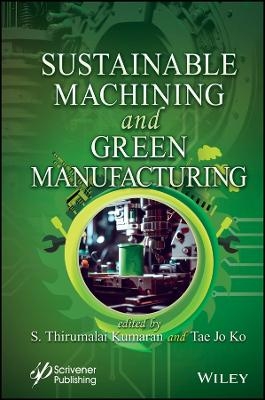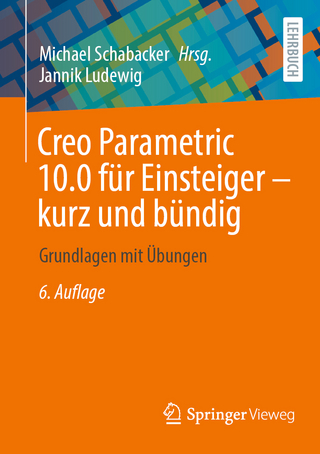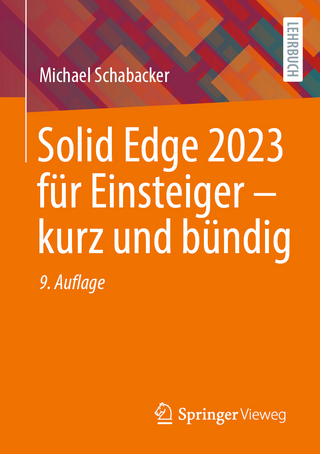
Sustainable Machining and Green Manufacturing
Wiley-Scrivener (Verlag)
978-1-394-19783-5 (ISBN)
As a knowledge roadmap, this book explains how to reduce, recycle, and reuse materials while promoting environmentally-friendly practices, such as dry machining and eco-friendly cutting fluids. With a thorough investigation of the synergy between natural fibers and epoxy composites—specifically showing how filler materials enhance mechanical properties—this book explores both the potential of sustainable reinforcements in polymer composites and the adaptability of these materials for diverse applications. The volume reveals how manufacturing methods can determine the mechanical prowess of biofiber-reinforced composites, and reviews how advanced composite materials are revolutionizing biomedical devices.
Readers will learn how environmentally conscious manufacturing processes can coexist with industrial production, with attention paid to the intricacies of composite filament production in the innovative world of additive manufacturing. Furthermore, the book explores the delicate balance between material selection and joining techniques, focusing on sustainability in the manufacturing process. Other topics include:
how natural materials can address environmental challenges, highlighting sustainable wastewater treatment;
how welding in sustainable manufacturing practices can bridge the gap between tradition and innovation;
the future of robotics where sustainability plays a central role in engineering design;
green manufacturing practices in the automotive industry;
waste reduction, using green principles to optimize manufacturing processes;
the synergy between design and sustainability in additive manufacturing, illustrating the potential for minimizing waste and energy consumption;
the intricacies of process optimization in additive manufacturing;
cutting-edge precision machining technologies that transform the usage of materials.
Audience
The book will be of importance to manufacturing engineers and policymakers in multiple industries, as well as researchers and postgraduate students in mechanical and manufacturing engineering, robotics, materials science, artificial intelligence and allied fields.
S. Thirumalai Kumaran, PhD, is an associate professor in the Department of Mechanical Engineering, PSG Institute of Technology and Applied Research, Chennai, India. He completed his PhD in mechanical engineering in 2015 from Kalasalingam Academy of Research and Education. He has published more than 100 articles in SCI journals and received a gold medal in manufacturing engineering from the Government College of Technology in 2008. Tae Jo Ko, PhD, is a professor at the School of Mechanical Engineering, Yeaungnam University, Gyeongsan-si, South Korea. He received a PhD in mechanical engineering from POSTECH, South Korea. Professor Tae Jo Koe has more than 300 publications in SCI journals, and has launched new research in rechargeable batteries and digital twins for manufacturing. He is the editor of the International Journal of Precision Engineering and Manufacturing and the Journal of Nanotechnology.
Preface xv
1 Effect of Granite Filler on Mechanical Properties and Free Damping of Silk-Sisal—Reinforced Epoxy Composites 1
K. Sripriyan and S. Karthick
1.1 Introduction 1
1.2 Material and Preparation 3
1.3 Result and Discussion 4
1.4 Conclusions 10
2 Effect of Plastic Particulate Addition on Polymer Composite Reinforced with Prosopis juliflora Fiber 13
Sakthi Balan G., Aravind Raj S., Jafrey Daniel James D. and Ramesh M.
2.1 Introduction 14
2.2 Materials and Methods 15
2.3 Results and Discussion 18
2.4 Conclusion 29
3 Effect of Various Manufacturing Techniques on Mechanical Properties of Biofiber-Reinforced Composites 33
M. Sasi Kumar, S. Sathish, M. Makeshkumar, S. Gokulkumar, L. Prabhu, S. Hemalatha, S. Ponnavan and Nancy Chopra
3.1 Introduction 34
3.2 Manufacturing Methods 35
3.3 Hand Layup Technique 36
3.4 Compression Techniques 39
3.5 Injection Technique 45
3.6 Filament Techniques 46
3.7 Vacuum-Assisted Resin Transfer Molding Technique 46
3.8 Spray Molding Technique 53
3.9 Conclusion 54
4 Electrical Discharge Machining of Al-B4C Composite for Biomedical Applications 65
S. Suresh Kumar, S. Thirumalai Kumaran, G. Kalusuraman and G. S. Samy
4.1 Introduction 66
4.2 Materials and Methods 68
4.3 Results and Discussion 71
4.4 Conclusion 76
5 Green Manufacturing of Natural Fiber Composite 79
Meenal Batra and Alka Bali
5.1 Introduction 80
5.2 Characteristics of Natural Fibers 81
5.3 Classes of Natural Fibers 82
5.4 Polymer Matrix 84
5.5 Applications of Natural Fiber Composites 85
5.6 Preprocessing of Natural Fiber Composites 87
5.7 Fabrication of Natural Fiber Composites 88
5.8 Additive Manufacturing 92
5.9 Additive Manufacturing of Different Composites 97
5.10 Critical Issues During Processing of Natural Fiber Composites 102
5.11 Conclusion 103
6 Manufacturing Issues and Process Parameters of Composite Filament for Additive Manufacturing Process 115
Jafrey Daniel James D., Ramesh M., Sakthi Balan G. and Aravind Raj S.
6.1 Introduction 116
6.2 Materials and Properties 117
6.3 Results and Discussion 120
6.4 Conclusion 128
7 Material Sustainability During Friction Stir Joining 131
Raheem Al-Sabur and M. Serier
7.1 Introduction 132
7.2 FSW Parameters 134
7.3 FSW Sustainability Review 136
7.4 FSW Sustainability Aspects 137
7.5 Recent Modifications in FSW Processes 143
7.6 Recent Applications of FSW 147
7.7 Conclusions 147
8 Plant-Based Biosorbents for Heavy Metal Removal From Wastewater 155
Narmadha V. and Siddhi Sreemahadevan
8.1 Introduction 156
8.2 Physical and Chemical Techniques for Heavy Metal Removal 157
8.3 Biological Methods for Heavy Metal Removal 158
8.4 Biochar 159
8.5 Plant-Based Biochar 162
8.6 A Comparison of Techniques for Removing Heavy Metals 170
8.7 Conclusion 171
9 Sustainability in Manufacturing: Welding’s Role as a Frontier 177
P. Arunkumar, N. Muthukumaran, K. S. Ramaneedharan, N. S. Mithun, B. Sanjay, K. Solaiyappan, S. Gokul and B. Arulmurugan
9.1 Introduction 178
9.2 Sustainability Assessment in Welding 181
9.3 Welding Processes Study on Sustainability Assessment 186
9.4 5S Lean Strategy for Sustainability Manufacturing 187
9.5 Conclusion 188
10 Sustainable Development of Redundant Articulated Robot Components Using Simscape Multibody 193
M. Saravana Mohan, P. S. Samuel Ratna Kumar and P. M. Mashinini
10.1 Introduction 194
10.2 CAD Modeling 200
10.3 Assigning Aluminum A308 Alloy for RAR 202
10.4 Kinematics and Dynamic Studies 203
10.5 Assigning DH Parameters 204
10.6 Simscape Multibody Simulation 207
10.7 Torque Results Using Simscape Multibody 207
10.8 Static Analysis Under Twisting Moment 210
10.9 Work Envelope of RAR 212
10.10 Fatigue Report of RAR 213
10.11 Conclusion 216
11 Implementation of Green Manufacturing Practices in Automobile Fields: A Review 221
Sampath Boopathi
11.1 Introduction 222
11.2 Green Manufacturing Production 228
11.3 Green Manufacturing in the Automobile Field 230
11.4 Green Manufacturing Practices in the Automotive Field 236
11.5 Case Study: Automobile Green Manufacturing Firm 240
11.6 Case Study: Water Conservation Technologies 243
12 Minimization of Manufacturing Industry Wastes Through the Green Lean Sigma Principle 249
Sampath Boopathi
12.1 Introduction 250
12.2 Challenges to the Manufacturing Sector 252
12.3 GT and Manufacturing Development Procedure 252
12.4 Green Lean Manufacturing Terminologies 255
12.5 Real-Time Problem Formulation and Research Approach 259
12.6 Green Lean Six Sigma Barriers 264
12.7 Conclusion 267
13 Design for Sustainable Methods in Additive Manufacturing 271
Akesh B. Kakarla and Ing Kong
13.1 Introduction 271
13.2 Ecological Impacts of Additive Manufacturing 275
13.3 Life Cycle Analysis 277
13.4 Implications of Sustainable Development in AM 278
13.5 Conclusions 282
14 Optimization of Fused Deposition Modeling Control Parameters Using Hybrid Taguchi and TOPSIS Method 289
B. Singaravel, T. Niranjan, M. Vasu Babu and K. Nagarjuna
14.1 Introduction 290
14.2 Literature Review 291
14.3 Experimental Setup 292
14.4 Methodology 296
14.5 Results and Discussion 300
14.6 Conclusions 302
15 Sustainable Machining of Monel 400 Using Cryogenic Treated Tool 305
S. Balakrishnan, K. Senthilkumar and S. Thirumalai Kumaran
15.1 Introduction 306
15.2 Materials and Methods 308
15.3 Results and Discussion 311
15.4 Conclusion 315
References 315
Index 317
| Erscheinungsdatum | 07.03.2024 |
|---|---|
| Sprache | englisch |
| Gewicht | 658 g |
| Themenwelt | Technik ► Maschinenbau |
| ISBN-10 | 1-394-19783-7 / 1394197837 |
| ISBN-13 | 978-1-394-19783-5 / 9781394197835 |
| Zustand | Neuware |
| Informationen gemäß Produktsicherheitsverordnung (GPSR) | |
| Haben Sie eine Frage zum Produkt? |
aus dem Bereich


